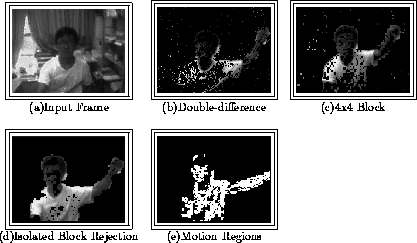
Figure 6: Image Processing
Publication,
Research,
Docs and Info,
KAMEDA



We implemented this method and applied it to real video frames. The human model used is shown in Figure 4. The video camera is set on the top of the desk bookshelf and focus on a person sitting in front of the desk. Camera position, camera direction, focus length are measured in advance. We constructed this system on SGI Indy (R4400 200MHz).
Figure 6 shows an example of the image processing. Figure (a) to (e) were taken at different moment. Figure(b) includes many noise pixels and they are rejected through (c), (d). In Figure (b), (c), (d), the pixels whose value is true in the double difference image express the original pixel value in the input frame. Final output Figure(e) passed to the motion estimation system includes small regions because each pixel in the motion regions is shown there.
The system generated 4.40 frames per second in average when the input video frame size was set to 320 pixels by 240 pixels and without motion estimation process. This frame rate depends on the number of motion regions in the video frame. See Table 1.
In the motion estimation experiments, we assumed that maximum rotation speed at each joint is 10 degrees per second. The experiments succeeded in simple exercises like waving hands. But there may exists difficulties in the present system. One of the reasons of the estimation failures is that one video frame consists of two fields. Since the current system merges two fields in one frame, shape of the motion regions do not reflect the correct shapes. Another reason of the estimation failures is that a body object once covers the incorrect motion regions, there is no way to update the joint angles to the right values.
Through the experiment, the average rate of the stable double
difference images for all the frames comes to  . This rate also
depend on what the person is working in the office which cause the
rate to be high.
. This rate also
depend on what the person is working in the office which cause the
rate to be high.
The current system can process only 1.1 frames per second in average. Speed-up and computation reduction is our future work.

Table 1: Frame Rate for Image Process


